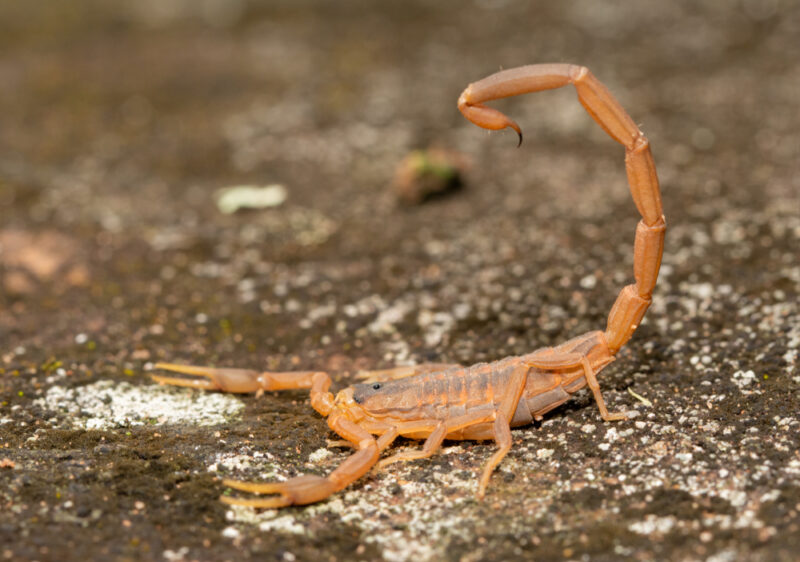The Striped Bark Scorpion (Centruroides vittatus) is the only scorpion species in the state of Arkansas. Centruroides vittatus is the most common scorpion out of the 90 or so different species of scorpions in the United States.
The venom of the striped bark scorpion isn’t very toxic to humans, and their sting is of minor medical importance. In fact, striped bark scorpion stings are no more dangerous than a bee sting.
However, all scorpion stings have the potential to cause severe allergic reactions such as anaphylactic shock. If you have severe symptoms such as blurred vision, muscle spasms, or difficulty breathing after experiencing a scorpion sting, seek immediate medical attention.
Common Striped Bark Scorpion (Centruroides vittatus)
Striped Bark Scorpions, which also go by the common names Plains Scorpion, Wood Scorpion, or Stripe Backed Scorpion, are Buthid Scorpions, just like the Arizona Bark Scorpion. However, their sting is not nearly as dangerous as that of the Arizona Bark scorpion. Common Striped Bark Scorpions are the most common scorpions in the United States.
Thousands of people are stung by them each year when they step on them with bare feet or come into accidental contact with them in some other manner, such as having one inside an article of clothing or turning over rocks or rotting logs with bare hands.
Unlike Northern Scorpions and Northern Black Hairy Scorpions, which never venture far from their burrows, Striped Bark Scorpions are wandering hunters. They venture long distances in search of food. Like all bark scorpions, they are natural climbers. Besides living under rocks, they climb trees and fence posts and have no problem climbing the walls of your home. They actually have a negative geotaxis, or in other words, they prefer an upside-down orientation. See
Striped Bark Scorpions live in a wide variety of habitats, such as deciduous woodland, coniferous forests, temperate grasslands, and deserts. During the day, they will take shelter under loose stones, in leaf litter, beneath loose bark, in crawl spaces or in wood piles, etcetera.
Like all scorpions, they are nocturnal creatures and will be under shelter until after sundown. What’s more, as all scorpions do, they have fluorescent compounds in their exoskeletons that make them glow under black light. If you are camping in an area where striped bark scorpions are active, it’s a good idea to go armed with an ultraviolet flashlight. Use the ultraviolet light to scan your campsite after dark. This tiny arachnid is not very dangerous, but they do pack a painful sting. I wouldn’t advise sharing your sleeping bag with one if you can avoid it.
Distributions of the scorpions Centruroides vittatus begin in the northern Mexico states of Chihuahua, Coahuila, Nuevo Leon, and Tamaulipas. It then extends northward up to the southern counties of Nebraska. Their range also extends longitudinally from the Sangre de Cristo mountains and Rio Grande of New Mexico in the west and the Missouri River and the Mississippi River in the east. The following states in the U.S. have populations of striped bark scorpions: Arkansas, eastern Colorado, Kansas, Illinois, Louisiana, Mississippi, Missouri, Nebraska, New Mexico, Oklahoma, Florida, Georgia, and Texas.
According to the Encyclopedia of Arkansas, striped bark scorpions are most numerous in the western part of the state. See
In areas with colder wintertime temperatures, striped bark scorpions survive by tolerating limited freezing of their body tissue. These scorpions then hibernate through the winter months. In areas with colder climates, these little guys may be more likely to enter houses during the winter months. Be sure to eliminate foundational cracks, weatherstrip any spaces around your doorway, and eliminate any other entry points that might allow these creatures easier access to your home.

What do striped bark scorpions look like?
All scorpions look a little bit like tiny land-dwelling lobsters with some distinctions. Lobsters have 10 legs, while scorpions have 8, and of course, lobsters don’t have a bulbous venom-filled stinger on the end of their tail, while scorpions do.
Adult striped bark scorpions are from 2 1/4 up to 2 3/4 inches long. An adult of this species is uniformly brownish yellow in color, with the exception of a distinctive pair of broad dark longitudinal stripes that run the length of its back, a triangular median dark spot at the top of its head, and the tip of the stinger which is brown or black.
Striped Bark Scorpion Behavior
Striped Bark Scorpions mate in the fall and also occasionally in spring or early summer. The mating process begins with the male engaging the female scorpion in an elaborate mating dance called the promenade a deux. At this time, the male maneuvers the female to a spot where he can deposit a sperm packet called a spermatophore for her reception.
The male must hold the female over the spermatophore long enough for her to receive it. Therefore, larger males successfully mate a larger percentage of the time. If the female accepts the male’s spermatophore, the pair join together and rub chelicera in the “kiss” stage. At this point, the female takes up the spermatophore. What follows is about an 8-month gestation, after which their offspring are born alive.
After the newborn northern scorpions free themselves from the birth membrane, they will climb up their mother’s walking legs and onto her back. The young scorpions ride there on their mother’s back in a grouped formation, only climbing down to feed on pellets that the female scorpions create for them when she feeds until they are sufficiently old to strike out on their own. This is generally after their first molt. They won’t be fully mature for three to four years. See
Also see:


